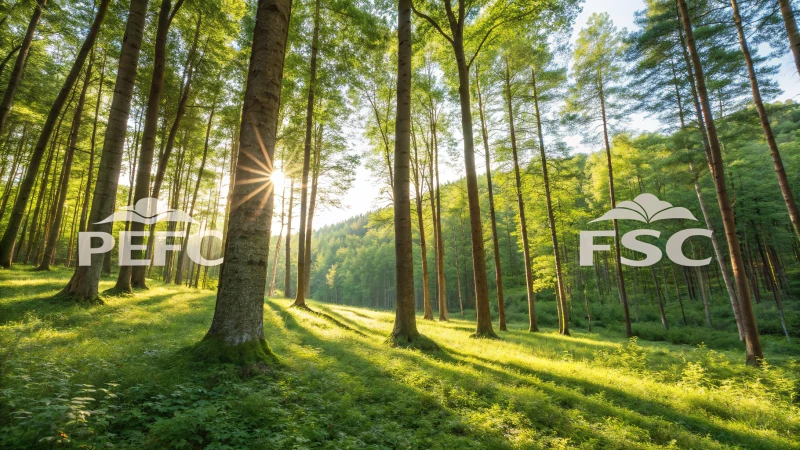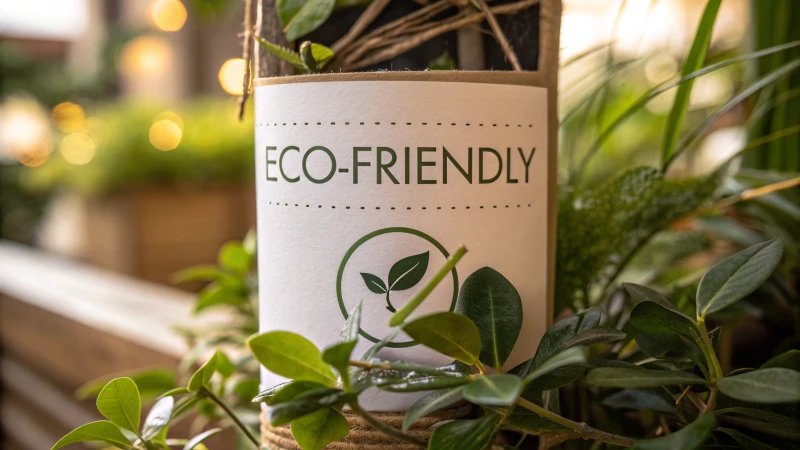
Ever wondered what truly makes disposable wooden cutlery sustainable? Let's dive into the certifications that ensure these products are eco-friendly.
Certifications like the Forest Stewardship Council (FSC) and Programme for the Endorsement of Forest Certification (PEFC) guarantee that disposable wooden cutlery is sourced sustainably, protecting forest biodiversity and reducing carbon emissions.
I remember when I first started paying attention to the eco-friendly labels on products. It was overwhelming—so many acronyms and logos! But soon, I realized that these certifications, like FSC and PEFC, are not just fancy stamps. They play a pivotal role in ensuring that the materials used in products like wooden cutlery come from responsibly managed forests.
These certifications are my way of ensuring that my choices reflect my values of sustainability and responsibility. They help me trust that my purchases are not contributing to deforestation but instead support practices that maintain ecological balance. For anyone like me who's passionate about making a positive environmental impact, understanding these certifications is key. They don't just influence what I buy; they affirm my commitment to a greener future.
FSC certification ensures sustainable wood sourcing.True
FSC certification guarantees that wood products are sourced sustainably, preserving forest biodiversity.
PEFC certification does not impact consumer confidence.False
PEFC certification enhances consumer confidence by ensuring products are sustainably sourced.
What Is the FSC Certification and Why Does It Matter?
Have you ever stopped to wonder if the wooden cutlery you're using is helping or harming our planet?
The Forest Stewardship Council (FSC) certification is a global hallmark of responsible forestry. It ensures that products are sourced from forests managed sustainably, balancing environmental, economic, and social benefits. This certification is crucial for eco-friendly consumers and businesses striving for sustainability.

Understanding FSC Certification
I remember the first time I came across FSC certification. It was during a trip to a local eco-friendly market, where a vendor passionately explained how this small logo on her products told a big story about sustainable forestry. Established in 1993, the Forest Stewardship Council (FSC)1 sets the gold standard for responsible forest management worldwide. It's like giving trees a voice, ensuring that every product with the FSC mark is sourced ethically and sustainably.
Key Principles and Criteria
FSC certification stands on ten robust principles, covering every corner of environmental, social, and economic responsibility. Picture this: it's not just about saving trees; it's about respecting the biodiversity they nurture, honoring the rights of indigenous communities, and ensuring fair labor practices. These principles remind me of a friend who works tirelessly to create harmony between nature and community. You can dive deeper into these principles through various resources2.
| Principle | Description |
|---|---|
| Environmental | Protection of ecosystems |
| Social | Community rights and workers' welfare |
| Economic | Sustainable economic viability |
Benefits of FSC Certification
For the Environment
- Biodiversity: Imagine walking through a forest where every tree has its unique role in a diverse ecosystem—this is what FSC-certified forests support by preventing deforestation.
- Climate Change Mitigation: I always feel a sense of hope knowing that sustainable practices in these forests help sequester carbon, battling the climate crisis one tree at a time.
For Businesses
- Market Access: In my line of work, having FSC certification is like holding a golden ticket to markets demanding sustainability credentials.
- Brand Image: Companies like WonBon3 leverage this certification to shine in their eco-friendly endeavors.
The Impact on Consumers
Every time I buy a product with the FSC mark, I feel part of a global movement towards transparency and ethical sourcing. It’s reassuring to know my choices support sustainable practices, making it a key selling point for conscious consumers like myself.
Challenges and Considerations
Of course, like any noble cause, FSC certification comes with its hurdles—think compliance costs and meticulous audits. Businesses must weigh these challenges against the long-term benefits of fostering sustainability. For those eager to explore more, detailed guidelines and case studies await through official channels4.
FSC certification was established in 1993.True
The Forest Stewardship Council (FSC) was indeed founded in 1993.
FSC certification only focuses on environmental aspects.False
It covers environmental, social, and economic principles.
How Do PEFC and FSC Certifications Differ?
I remember the first time I tried to make sense of forest certifications; it felt like learning a new language.
PEFC and FSC certifications differ in their origins, focus areas, and certification processes. While both aim to promote sustainable forest management, PEFC is more flexible with national standards, whereas FSC has a more unified global approach.

Origins and Global Reach
I still recall when I first discovered the world of sustainable forestry. It was like opening a door to a new realm where every tree had a story to tell. The Forest Stewardship Council (FSC)5 was among the first certifications I encountered. Established in 1993, it operates globally with a single set of standards, like a universal language for forests everywhere. Contrast this with the Programme for the Endorsement of Forest Certification (PEFC)6, founded in 1999 to support small forest owners in Europe. Its roots are deep in national standards, adapting like a chameleon to its local environment.
- FSC: It's like the Esperanto of forest standards—global and unified.
- PEFC: Think of it as the polyglot, adapting to each country's native tongue.
Certification Processes
Both systems pride themselves on their rigorous certification processes. However, they execute them quite differently. FSC's ten principles are like commandments that apply no matter where you are—making it a reliable choice if you value consistency across borders.
| Certification Feature | FSC | PEFC |
|---|---|---|
| Global Standards | Yes | No |
| National Standards | No | Yes |
| Third-party Auditing | Yes | Yes |
Whenever I hear "third-party auditing," I think of it as having an impartial judge at a cooking contest. It's mandatory for both, ensuring that neither plays favorites.
Focus Areas and Flexibility
FSC's focus is much like a philanthropist—keen on ecological and social aspects, ensuring that biodiversity and community welfare aren't just buzzwords. Meanwhile, PEFC feels like a local community leader, prioritizing local involvement and economic viability through national dialogues.
- FSC: Aims for the stars with global ecological and social criteria.
- PEFC: Stays grounded by endorsing what works best locally.
Consumer Trust and Market Impact
Both certifications are like trusted friends in the market, but they cater to different circles. FSC often attracts those who are environmentally conscious and demand rigorous standards, while PEFC's adaptability makes it a favorite in regions that lean heavily on national standards.
Knowing these differences can be a game-changer. For someone like Michael7, making informed choices about sustainable sourcing isn't just about ticking boxes; it's about aligning these decisions with broader sustainability goals and regional needs.
FSC was established before PEFC.True
FSC was founded in 1993, while PEFC was established in 1999.
PEFC requires compliance with global standards.False
PEFC allows for national standards, unlike FSC's global standards.
Why Are Certifications Important for Consumer Trust?
Ever wondered why those tiny certification labels make such a big difference in what we buy?
Certifications validate a product's claims about quality and sustainability, reassuring consumers that they are making informed, responsible choices. This trust boosts brand reputation and fosters long-term consumer loyalty.

The Role of Certifications in Consumer Decision-Making
I remember the first time I had to choose between two seemingly identical products. It was overwhelming until I noticed one had a little badge from the Forest Stewardship Council (FSC)8. That tiny label spoke volumes—it told me about responsible forestry management, something I deeply care about. It was like finding a friend who shares your values in the crowded aisles of a store.
Building Trust in Sustainability Claims
As more of us wake up to environmental issues, we’re becoming pickier about what we buy. Certifications like FSC aren’t just labels; they’re promises that the things we love are made with the planet in mind. Remember that time you bought a product with a Fair Trade label and felt good knowing it supported ethical labor practices? It’s these small assurances that make us loyal to brands, binding us together in a shared commitment to sustainability.
| Certification | Assurance Provided |
|---|---|
| FSC | Responsible forestry management |
| Fair Trade | Ethical labor practices |
| Organic | Absence of synthetic chemicals |
Enhancing Brand Credibility Through Certifications
Getting certified isn’t just about ticking boxes; it’s about standing tall in a sea of competitors. Think of the Fair Trade certification9 as a badge of honor, telling everyone your brand champions fair labor practices. It’s like inviting ethically-conscious consumers to join a club where their values are respected and shared.
Meeting Consumer Expectations in E-commerce
Shopping online can feel like navigating through an endless maze of options without the chance to hold products in our hands. This is where certifications step in as a virtual handshake, giving us confidence that we’re making good choices. On platforms like Amazon, highlighted certifications help cut through the noise, guiding us to products we can trust.
Market Differentiation Through Certified Products
In today’s crowded markets, standing out is tough. But certifications can be that unique flair, signaling superior quality or sustainability. Picture this: you’re browsing for eco-friendly goods, and a certified product catches your eye—not just for its price but for its commitment to bettering our world. That’s powerful differentiation right there.
For more insights into the impact of certifications, see this study on consumer trust10 which explores how certifications influence purchasing behavior across various industries.
FSC certification guarantees ethical labor practices.False
FSC ensures responsible forestry management, not labor ethics.
Certifications enhance consumer trust in online shopping.True
They provide assurance about product quality without physical inspection.
How Does Sustainable Cutlery Impact Environmental Conservation?
Ever felt a pang of guilt tossing out plastic cutlery? Switching to sustainable options is like a breath of fresh air for our planet.
Sustainable cutlery plays a crucial role in environmental conservation by cutting down on plastic waste, reducing carbon emissions, and promoting responsible resource use, thus supporting healthier ecosystems and encouraging sustainable living practices.

The Role of Sustainable Cutlery in Reducing Plastic Waste
I remember the time I organized a family picnic and the aftermath was a pile of plastic utensils that made my heart sink. That's when I realized the impact of our choices on the environment. Plastic cutlery, once discarded, ends up cluttering our oceans and landfills for centuries. By switching to sustainable cutlery made from biodegradable materials11, I've felt more at peace knowing I'm contributing to cleaner environments and healthier ecosystems.
Lowering Carbon Emissions Through Sustainable Choices
A while back, I read about how the production and disposal of plastic cutlery contribute significantly to greenhouse gases. It hit me—every small choice adds up. Opting for bamboo or FSC-certified wood not only lessens emissions during production but also ensures they decompose naturally, leaving no harmful gases behind. It's a simple change that supports global efforts to combat climate change12.
| Material | Decomposition Time | Carbon Emissions |
|---|---|---|
| Plastic | 500+ years | High |
| Wood | 3-5 years | Low |
| Bamboo | 1-2 years | Low |
Encouraging Responsible Resource Use
Switching to sustainable cutlery felt like discovering a hidden path to responsible resource use. Products made from fast-growing plants like bamboo or responsibly sourced wood help preserve forests and biodiversity. Knowing that certifications such as FSC13 ensure materials are harvested responsibly gives me confidence that my choices help maintain ecosystems and foster biodiversity.
The Economic Benefits of Sustainable Cutlery
Beyond the environmental impact, I've noticed how businesses adopting eco-friendly practices often gain increased customer loyalty. People want to support brands committed to sustainability. Although initial costs may seem higher, the long-term savings from reduced waste management expenses and improved brand image often outweigh these costs.
Incorporating sustainable cutlery into everyday use has been my way of contributing to environmental conservation. As more of us make this switch, the collective impact on reducing waste, lowering emissions, and encouraging responsible resource use becomes increasingly significant.
Sustainable cutlery reduces plastic waste.True
Sustainable cutlery, made from biodegradable materials, lessens plastic reliance.
Bamboo cutlery increases carbon emissions.False
Bamboo cutlery has a low carbon footprint, reducing emissions overall.
Conclusion
This article explores the importance of certifications like FSC and PEFC in ensuring disposable wooden cutlery is sustainably sourced, promoting environmental responsibility and consumer trust.
-
Discover the origins and mission of the Forest Stewardship Council to understand its global impact on sustainable forestry. ↩
-
Gain insights into the ten core principles of FSC certification to understand how they promote sustainable forestry practices. ↩
-
Learn how WonBon integrates FSC certification into its business model to enhance sustainability efforts. ↩
-
Explore the challenges businesses face in obtaining FSC certification to understand the complexities involved. ↩
-
Discover the foundational goals and global reach of the FSC to appreciate its impact on sustainable forestry. ↩
-
Learn about PEFC's origins to understand its focus on supporting small forest owners and national standards. ↩
-
Understand how certifications like FSC and PEFC affect procurement strategies and sustainability commitments. ↩
-
Discover how FSC certification ensures responsible forestry and boosts consumer confidence in sustainable products. ↩
-
Explore why Fair Trade certification enhances brand credibility by advocating ethical practices. ↩
-
Learn about the role of certifications in influencing consumer choices across different sectors. ↩
-
Learn about the various biodegradable materials used in creating eco-friendly cutlery. ↩
-
Discover how choosing sustainable cutlery can help mitigate climate change. ↩
-
Understand why FSC certification is vital for ensuring responsible sourcing of wood. ↩

